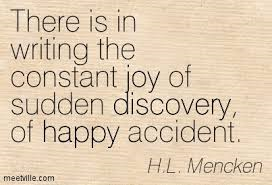 If you’re a guy you might not be shaving this month, but I hope your hipster beard isn’t blocking your keyboard because it’s National Novel Writing Month. That’s right, in between Halloween and the start of the holiday season that we should all be embracing (instead of the start of the holiday season that the stores want us to embrace) is an important month for all of us who have voices in your heads. If you don’t have voices in your head, you’re not listening close enough and need to turn down your iPod.
If you’re a guy you might not be shaving this month, but I hope your hipster beard isn’t blocking your keyboard because it’s National Novel Writing Month. That’s right, in between Halloween and the start of the holiday season that we should all be embracing (instead of the start of the holiday season that the stores want us to embrace) is an important month for all of us who have voices in your heads. If you don’t have voices in your head, you’re not listening close enough and need to turn down your iPod.
As you have probably guessed, I’m participating in Nanowrimo. I look forward to this event every year, but this year I decided to try something new. In case you don’t now how Nanowrimo works, you’re supposed to write 50,000 original words from Nov. 1 to Nov. 30. In theory, these 50,000 words should be the beginning, middle, and hopefully end of one story, but no one is policing you, so I say, write whatever you want. Even though you can’t start writing until November 1, you can prepare to write. In October, you can outline your story, design some characters, and do research. I have done this in the past with mixed results.
This year, mostly because I am working on several other writing projects, I decided to do no preparing for Nanowrimo. I wouldn’t even think about what I wanted to write. I would start typing on November 1 and see where it goes. Around October 22, I came up with a great fantasy story, complete with setting, characters, and plot. I thought for a moment that it was going to be my Nanowrimo story. But I remembered my plan and shelved it.
I call myself a pantser (a cute word for a discovery writer), but I usually think I should outline a little bit. I don’t know anyone who is 100% pantser. Apparently I am, so I’m embracing that side of me this year. When I’m not writing I’m not thinking about my book. In fact, I feel like the ideas are flowing from the creative part of my brain directly to my fingertips. They’re not going to any other part of my brain, which is why when I’m not typing I’m not thinking about my story. The thinking portion of my brain has not been informed by the creative part of my brain that there is anything to think about. (This is probably not neurologically accurate, but it makes sense to me.)
The big question is, how am I doing? Are the words flowing like chocolate syrup, or am I sitting in front of a blank screen wishing I’d never signed up for Nano, and wondering if there’s any Halloween candy left (nope, it’s all gone.) The answer is… this is my best Nano ever. Today is day nine and I have already written 28,000 words. I hope to reach 50,000 words by Friday. And I won’t stop there. My story may be almost done, but I am going to keep writing and discover if these characters want a second book. My daily average is 3,138 words and I feel like I could do more.
I hope you are enjoying Nano this month. If you are struggling, ask yourself a question. Are you a pantser or a plotter and are you fighting your natural writing style? If you are a pantser, toss the outline you thought you had to make and let your creative side take over. If you are a plotter, don’t worry about the rules that say every word should be part of your story. Use some of your word count to create an outline.
Writers sometimes treat pantser vs. plotter like Coke vs. Pepsi. There is only one right choice and the other is just gross. However, that is not true. Pantsers should be pantsers, and plotters should be plotters. It’s not my way or the highway. I can now say I’m a pantser and if being a pantser enables me to write 100,000 words in November I’m a happy pantser. Whatever type of writer you are, I hope you’re happy, too.
“There is in writing a constant joy of sudden discovery, of happy accident.” H. L. Mencken

